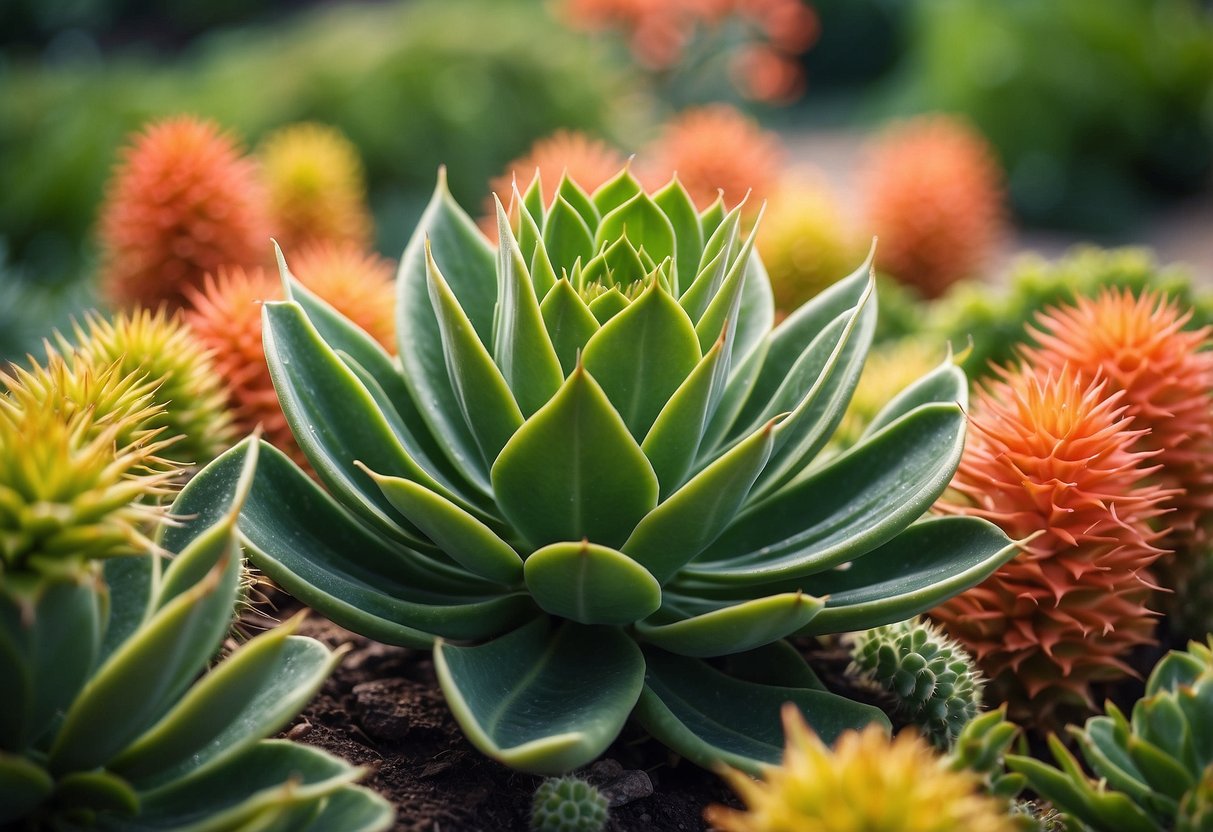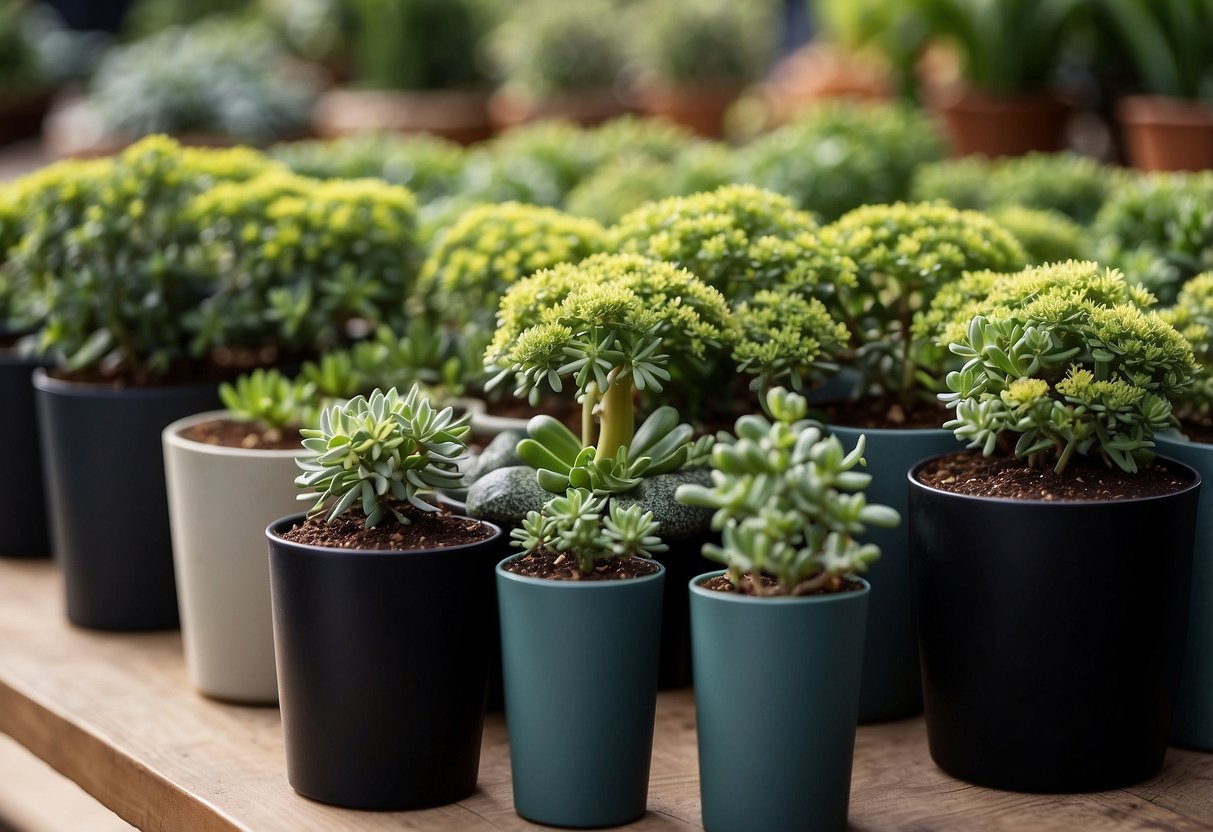Euphorbia Garden Ideas: Spruce Up Your Outdoor Space
Thinking about adding some unique charm to your garden? Euphorbia, with its over 2,000 diverse species, can be a perfect choice. This plant family offers a range of options, from bold succulents to delicate, flowering varieties that can enhance any garden.

What makes euphorbia stand out is its versatility and ease of care. Whether you have a large backyard or a small balcony, you can find a type of euphorbia that suits your space and aesthetic. The right combination can transform your garden into an enchanting oasis.
1) Planting with Euphorbia characias ‘Tasmanian Tiger’

When you add Euphorbia characias ‘Tasmanian Tiger’ to your garden, you’ll enjoy its stunning variegated foliage. The leaves are gray-green with creamy-white edges, creating a striking appearance.
Plant this spurge in well-drained soil. It thrives best in full sun. The chartreuse flowers bloom in spring, adding color and interest.
Prune spent flower stems in summer to encourage new growth. This evergreen subshrub is also drought-tolerant once established, making it a low-maintenance choice for your garden.
2) Combining Euphorbia with Succulents

Pairing Euphorbia with succulents can make your garden look vibrant and diverse. The bold leaves of Euphorbia contrast nicely with the fleshy leaves of succulents like Aloe or Echeveria.
You can also pair Euphorbia with Graptopetalum and Aeonium for an interesting blend of shapes and colors. Both plants thrive in similar conditions, needing plenty of sunlight and well-draining soil.
For a stunning display, consider planting Euphorbia next to Crassula or Lithops. This combination will add texture and depth to your garden.
3) Euphorbia and Ornamental Grass Pairings

Pairing Euphorbia with ornamental grasses can create a stunning visual effect in your garden. Euphorbia’s unique foliage and flowers complement the graceful movement of grasses.
Combine Euphorbia with variegated red fountain grass to add bold color. Try planting Euphorbia next to airy sweet alyssum for a soft, enchanting look.
Pair Japanese blood grass with Euphorbia for contrasting textures. The red tips of the grass play beautifully against Euphorbia’s green tones, making your garden vibrant and eye-catching.
4) Creating a Euphorbia Rock Garden

Start with large rocks to form the base of your garden. These rocks will provide structure and mimic a natural environment.
Choose a variety of Euphorbia plants. The Euphorbia trigona rubra can add vibrant color, while Euphorbia myrsinites is great for cascading over stone walls.
Space your plants to allow room for growth. Make sure the soil is well-draining. You may need to water more often if you live in a dry climate to keep the plants healthy.
5) Using Euphorbia as Ground Cover

Euphorbia can be a great option for ground cover in your garden. You might like Euphorbia myrsinites, also known as Myrtle Spurge. It stays low to the ground, reaching only about 20 cm (0.6 ft) in height.
This variety works well in dry, sunny spots. Its trailing stems and blue-green leaves create a unique texture that stands out.
For something different, consider the Wood Spurge (Euphorbia amygdaloides). This bushy evergreen grows 18-24 inches tall and has bright yellow flowers in spring. It thrives in shady areas, adding a splash of color.
6) Euphorbia Accent in Contemporary Gardens

Euphorbia is perfect for modern garden designs. Its clean lines and unique shapes fit well with sleek, minimalist styles. The bright green hues of Euphorbia characias subsp. wulfenii can add a striking pop of color.
Incorporate Euphorbia with other bold plants like Cordyline for a stunning contrast. Mixing textures and colors can create a visually appealing garden.
Remember, Euphorbia requires well-draining soil. Plant it in a spot with plenty of sunlight to keep it thriving. Maintenance is simple—just prune after blooming to encourage new growth.
7) Euphorbia in Mediterranean Garden Themes

Euphorbia is a perfect plant for Mediterranean garden themes. Its drought-tolerant nature makes it ideal for hot, dry climates.
You can mix Euphorbia with other Mediterranean plants like agave and aloe for a stunning look. These plants complement each other well and need similar care.
Euphorbia x pasteurii works beautifully in gravel gardens. Its dome-like shape and evergreen foliage add a touch of elegance to your garden.
For a splash of color in small spaces, Euphorbia does great in pots. They’re easy to maintain and look fantastic year-round.
Consider using Euphorbia for cascading effects in your garden. Euphorbia myrsinites can create beautiful, flowing lines over stone walls.
8) Dwarf Euphorbia Varieties for Containers

Dwarf Euphorbia varieties are perfect for small spaces. They thrive in containers and add a charming touch to any garden area.
Euphorbia myrsinites, also called Donkey Tail Spurge, is a great choice. It has blue-green foliage and spreads nicely in pots.
Euphorbia amygdaloides var. robbiae, known for its dark green leaves, is another lovely option. This variety is hardy and low-maintenance, making it ideal for containers.
9) Euphorbia with Spring Bulbs

Pairing euphorbia with spring bulbs can create a stunning display in your garden. The bright greens of euphorbia contrast nicely with the vibrant colors of bulbs like tulips and daffodils.
You might consider using Euphorbia amygdaloides var. robbiae alongside alliums for a pleasing visual mix. The architectural blossoms of the bulbs will stand out against the lush foliage of the euphorbia, making your garden pop with color.
10) Colorful Euphorbia Borders

You can create long-lasting contrasts with vibrant Euphorbia borders. Try pairing the bright greenish-yellow flowers of Euphorbia palustris with the burnt orange blooms of Euphorbia griffithii for an eye-catching display.
For a lively twist, add Euphorbia amygdaloides var. robbiae, which thrives in shaded spots, bringing a lush green touch to your garden boundaries. These plants not only add color but also create beautiful, structured borders that will enhance your garden’s appeal.
Designing a Euphorbia Garden

Creating a Euphorbia garden involves selecting the best varieties, planning the layout, and pairing them with complementary plants. Loved for their unique textures and vibrant hues, Euphorbias enhance any garden space.
Choosing the Right Euphorbia Varieties
When choosing Euphorbia varieties for your garden, consider factors like size, color, and growth habit. Varieties like Euphorbia amygdaloides var. robbiae are great for shade, with dark green leaves and a compact growth habit. For a cascading effect, try Euphorbia myrsinites. It sprawls beautifully over rock walls, adding texture and visual interest.
Some Euphorbia, like Euphorbia characias ‘Wulfenii’, feature tall, striking blooms that can act as focal points. These varieties also attract pollinators, enriching your garden’s ecosystem. Make sure to select varieties that will thrive in your specific USDA zone and light conditions. Find more detailed information at Gardenista’s guide to Euphorbia.
Garden Layout and Planning
Before planting, sketch out a garden layout to visualize how your Euphorbia will fit into the space. Consider placing taller varieties at the back and smaller ones in front. This layering creates depth and visual interest. Design pathways around your garden to make maintenance easier and provide different vantage points.
Raised beds or rock gardens can be ideal settings for Euphorbia, as they prefer well-drained soil. Grouping plants with similar care needs together simplifies watering and upkeep. Remember to leave space for growth since Euphorbia can spread. Check out tips on pruning and maintaining Euphorbia at Harmony in the Garden.
Complementary Plants for Euphorbia
Pairing Euphorbia with complementary plants enhances the garden’s beauty. Suitable companions include lavender, rosemary, and sedum. These plants share similar soil and light requirements and contrast nicely with Euphorbia’s textures.
Avoid planting Euphorbia near aggressive spreaders that might compete for resources. Instead, choose plants like ornamental grasses or succulents, which provide a subtle backdrop. To explore more on effective plant pairings, visit Garden Housing’s guide on companion plants.
By thoughtfully selecting and pairing varieties, planning your layout, and combining with suitable companions, your Euphorbia garden will thrive and bring joy for years.
Caring for Your Euphorbia Garden

Proper care for your euphorbia plants will help them thrive. Focus on watering, soil needs, fertilization, and pruning to keep your garden healthy and beautiful.
Watering and Irrigation Tips
Euphorbias do not need much water. Overwatering can lead to root rot. Use well-draining soil and water every seven to ten days. Check the top inch of soil; if it’s dry, it’s time to water. Using a terra-cotta or clay pot can help wick away excess moisture. In dry climates, you may need to water more frequently.
Tips:
- Water in the morning.
- Avoid splashing water on the leaves.
- Use a watering can with a narrow spout for precision.
Soil and Fertilization Needs
Euphorbias thrive in well-drained, slightly acidic to neutral soil. A sandy soil mix with a pH between 5.0 and 7.0 is ideal. For container plants, use a cactus or succulent potting mix. Fertilize sparingly; twice a year with a balanced, water-soluble fertilizer should be enough.
Fertilizer Tips:
- Apply fertilizer in spring and summer.
- Avoid over-fertilizing, which can cause weak growth.
- Use a diluted solution to prevent burning the plant.
Pruning and Maintenance
Pruning euphorbias encourages healthy growth and keeps them looking neat. Cut back in autumn to manage size and shape. Always use clean, sharp tools to prevent the spread of disease. Wear gloves; euphorbia sap can cause skin irritation.
Pruning Steps:
- Identify dead or damaged stems.
- Cut at a 45-degree angle.
- Dispose of cuttings safely.
Regular maintenance includes checking for pests and trimming overgrown areas. Removing spent flowers can also promote new blooms, keeping your euphorbia garden vibrant.
By focusing on these care tips, your euphorbia garden will remain a stunning addition to your home.







